|
|
 |
|
|
The Beginnings of the Waffen-SS: The Formation - Part One
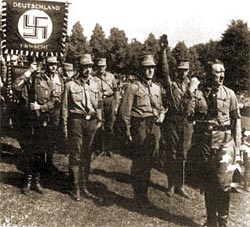 |
The Beginnings of the Waffen-SS Part One
The Formation
by Andy Blozinski
Politics in parts of Europe between the wars could sometimes be a dangerous endeavor and Germany was certainly in that category. The competing radical factions within Germany were not unusually literally fighting for control in sometimes armed conflict. During the 1920s, the National Socialist German Workers Party (NASDAP, often verbally shortened to Nazi) formed Shutz Staffeln (SS), or protection squads to provide local security for party officials, while the Sturmabteilung (SA), also known as the Stormtroopers or Brown Shirts handled active enforcement and strong arming against political opponents.
|
With the growth of the Nazi party, the SS became a nationwide politically controlled internal police style protection force with each regional unit temporarily reclassified as Politische Bereitschaften, or Political Standby Detachments, and the SA began to take on an organised military structure as it passed up the real army in size by 1931 and also branched out into military style youth training with the early version of the Hitler Youth, known as the Jugenbund. While the SA helped strong arm Adolf Hitler and the Nazis into complete power in 1933 with gangland style violence where needed, the SA leadership and its head, Ernst Rohm, envisioned this paramilitary force as a complete replacement for the classic and aristocratic German army.
|
The traditional German armed forces had longstanding social and political connections to the populace as veterans filtered back into society from service and took functional roles. Oftentimes these were civil roles, such as firemen, policemen, or civil servants. After World War I, the Treaty of Versailles temporarily accelerated these connections as the army was limited to a maximum of 100,000 men strong (known as the Reichswehr) and an artificially large group of personnel from the armed forces suddenly entered the workforce. When Hitler secured complete political power in 1933, the SA became extraneous as Germany had become a one party state and the only needed political armed role was smaller scale protection that was covered by the SS.
Right: The Treaty of Versailles.
|
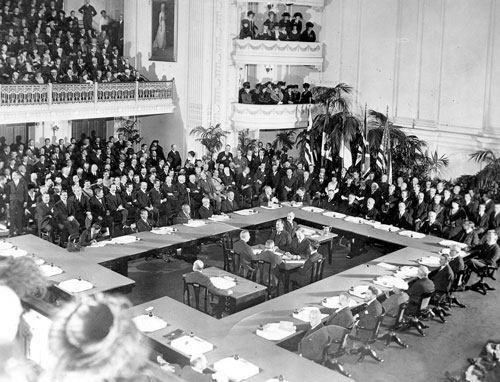
|
The now 2-3 million strong organised SA was its own army. It became potential political competition within the Nazi party if it wanted to and it actively made its intention clear to completely replace the socially and societally established German armed forces that it now outnumbered. Rohm was also more pre-disposed to the original intended ideals of a socialist party than Hitler was. This didn’t go over well with the industrialists and other owners of large capital. It was time for a change as Ernst Rohm and the SA were in the position of being a perceived or real liability to multiple groups that were important, including the Fuhrer.
|
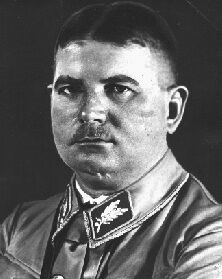 |
The crude beginnings of what later became the Waffen-SS, took the form of the 117 man Leibstandarte Adolf Hitler (LAH) , commanded by Sepp Dietrich, which was later renamed the Leibstandarte SS Adolf Hitler (LSSAH). This was Hitler’s personal guard and armed force within the SS structure under the newly empowered party in control. It was formed in 1933 and it grew to roughly 800 men that year. Its first major task was to take care of the SA in 1934. In what became known as the Night of the Long Knives, Ernst Rohm and the majority of the upper level SA leadership was rounded up and killed. The LSSAH and the necessary regional units of the Politische Bereitschaften played a central role in carrying out this gruesome task.
Left: Ernst Rohm.
|
This removed major competition within the party and was viewed favorably by the military and some of the public. Hitler was also able to scapegoat Rohm for some party activities. With its main leadership completely gone, no party support and important societal groups against it, the SA disintegrated. The SS was now the only armed party force. While this truly solidified Hitler’s political power, the situation was never as straightforward as it seems. There was still a significant element within Germany that was unsupportive of Hitler and there certainly would be when Hitler’s longer term plans to take other territories came to pass. The SS was more clearly and functionally broken into the Allgemeine SS and the SS Verfugungstruppe (SS-VT), or SS Dispositioned Troops.
|
The Allgemeine SS took care of governmental and
party administrative and organisational duties, intelligence, counter
intelligence, propaganda and basic internal policing. The SS-VT would
become an armed force structured like the army. The excuse was for them
to enforce armed security as necessary inside Germany at Hitler’s
disposal, although they would be allowed to form one combat division
only in time of war and only under regular army control; in deference to
the traditional army and as a gesture to them. On the surface, the
SS-VT were to be a national formalised and kind of bureaucratised
organisation of the previously regional Politische Bereitschaften,
formed in an army military structure, although specifically not part of
the army.
|
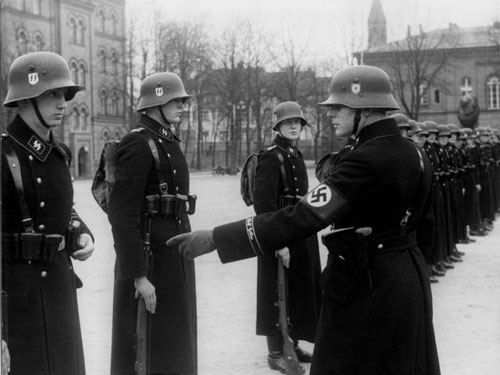 |
| It was somewhat similar to the
Soviet NKVD in its originally stated role as an internal army to protect
the government against sedition, mainly advertised as communism in this
case. It was not totally approved of by the established traditional
army, but they put up with it because the actions against the SA were
seen as a purposeful gesture, the purposely small size wasn’t viewed as a
threat and the deference to traditional army control was seen as a
further gesture. A third major branch of the SS, the SS
Totemkopfverbande (SS-TV) was established shortly afterwards to run the
concentration camp system. |
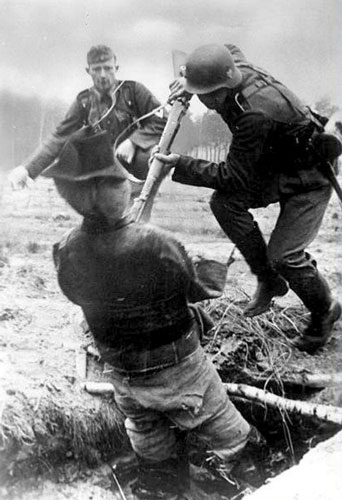 |
The SS-VT was officially established on 24 September 1934 for
organisational and preparation purposes, but was not publicly
acknowledged for another 6 months. It was set up with the traditional
army military structure and counted as full military service, but the
rank system often had different names (and insignia) on purpose to
denote the force was not part of the traditional army. Although the
SS-VT relied on the Reichswehr initially for equipment allocations, it
was to be set-up independently for training in personnel and facilities.
There were two officer schools. Paul Hausser
came out of retirement from the army with the rank of
SS-Standartenfuhrer to supervise training and to run the officer
schools. He set out to make this force militarily equivalent to the
regular armed forces as inspector general. The Reichswehr still had the
trappings of the old aristocracy in it as the traditional army, along
with connecting social limitations for advancement. The SS-VT was
different in that only candidates with previous military service were
allowed to take or train for officer positions, thus many ended up
serving as enlisted men before becoming officers.
|
| There were also some Reichswehr (and later Heer)
army officer transfers. The SS-VT not only offered the enticement of
joining a force deemed elite, but allowed for more upward mobility to
officer ranks from enlisted ranks in an atmosphere that had an increased
acceptance of meritocracy. Felix Steiner, a veteran of WW I and
previously of the SA, was to shortly have a great influence on the
direct training regimen of the enlisted men when he volunteered with the
second armed SS regiment that was formed which would be the true start
of the SS-VT. |
|
The SS armed forces were initially comprised of four regiments, based upon the regular army motorised infantry structure. First, the LSSAH was expanded into a regiment (Many recruits were from the Politische Bereitschaften), but it was only along a separate but somewhat parallel path with the other regiments that were the SS-VT. This was a combination of its different role as the Fuhrer’s official guard and the pride of its commander, Sepp Dietrich. The training regimen of LSSAH was not coordinated by Paul Hausser, as with the other regiments as the LSSAH was not actually part of the SS-VT.
LSSAH was later folded into the Waffen SS that the SS-VT became, but at this point there were some significant differences. LSSAH training was less stringent and did not include any significant influences or guidance from Hausser or Steiner. LSSAH was sometimes derisively referred to as the asphalt soldiers by the other SS-VT regiments, due to their extensive ceremony and parade duties and some jealousy for the Fuhrer’s favorite regiment that had a special place. The core role of the LSSAH as the Fuhrer’s guard helped politically in a number of ways. It emphasised the impression that the SS-VT was not a threat to the regular army, but more of a protection unit for the state. It also helped recruiting for the SS-VT regiments as the LSSAH status of honor guard helped the elite motif.
Right: Joesf "Sepp" Dietrich.
|
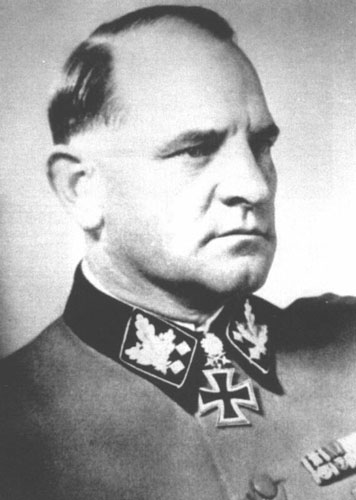 |
To fill its ranks, The LSSAH primarily drew from the politically oriented Politische Bereitschaften, but also recruited from the SA and the Treaty of Versailles limited regular army Reichswehr. The other new regiments to be formed drew from a mix of sources and tended to be slightly less political as they drew more from the general populace. In all cases, there were some basic strict physical fitness criteria established and candidates needed a clean criminal record. Heinrich Himmler, central leader of the entire SS, did not require party membership, but directed that it would favor a recruit for acceptance. Jugenbund (and later Hitlerjugend) service was also to a new recruit’s favor. All recruits had to establish a standard of racial purity. Enlisted men had to prove pure Aryan ancestry back to 1800, while officers (or officer candidates) had to prove theirs to 1750. There was a minimum height requirement of 5’-10”, 5’-11” for the LSSAH.
|
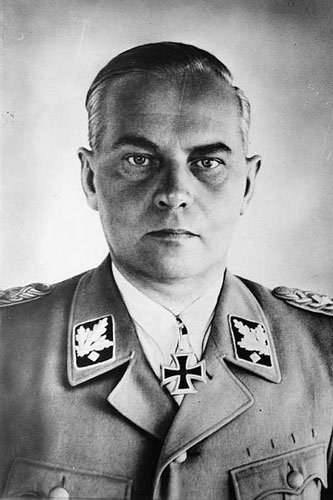 |
The 1st battalion of the first SS-VT regiment Deutschland began very much like the LSSAH in that its core of officers was recruited primarily from the politically reliable Politische Bereitschaften back in October of 1933 in preparation, although it was more regional than the LSSAH, being mostly from the Bavarian Politische Bereitschaften and was billeted in Munich. Later on when it filled out with the formal establishment of the SS-VT, the sources of its recruits were broader, but still mostly from the region of Bavaria. 2nd battalion was primarily Ex-SA or SS Austrians who had left their country for Germany, due to the banning of Nazi political entities in Austria. They were promptly given German citizenship. 3rd battalion drew its officers from 1st and 4th battalions and then recruited its enlisted men from the same areas as those battalions. 4th Battalion was a bit of a mix of Germany, but the majority came from the Wurttemburg area. 4th battalion is of interest in that it initially had a shortage of NCOs and this was uniquely made up for by temporarily drawing directly from the Reichswehr (later Heer) regular army active cadre. As 4th battalion grew its own NCO ranks, some were sent to the regular army for leadership instruction and the result was the first bridge building personnel exchange and inter-service cooperation.
Left: Felix Steiner.
|
| SS-VT regiment Deutschland overall is important to the early stages of
the SS-VT because its commander of 3rd battalion, Felix Steiner, had
some strong opinions on the training and employment of soldiers in the
field that were first implemented throughout the regiment and then
accepted for implementation throughout the SS-VT under Paul Hausser as
inspector general, except the separated LSSAH. Less emphasis was placed
on coordination of troops with marching and command drills. More
emphasis was placed on combat drills and physical fitness. |
Field craft and infiltration were emphasised over direct attack and troops were cross trained so any potential loss of leadership could be immediately replaced with equal competence. Troops were trained to organise small assault detachments as necessary to accomplish specific tasks as per the storm battalions of World War I. When all four battalions were established and formally became SS-VT Regiment Deutschland in 1936, Felix Steiner became its first commander. In the longer term, its status as an original SS combat unit and its role in the formulation of the original system wide training philosophy resulted in SS-VT regiment Deutschland becoming the source of officers replacements for other units and new officer cadre for many newly forming units.
|
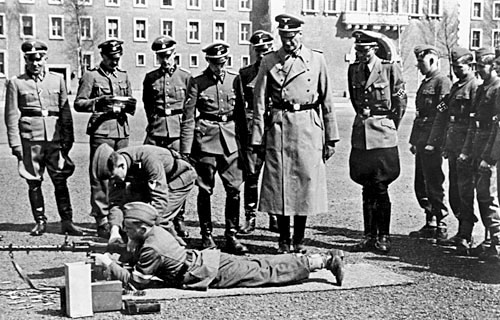
|
The 2nd new SS-VT regiment to be formed was Germania. Three infantry battalions, a specialist motorcycle company as well as anti-tank gun and infantry gun companies were recruited from the Hamburg area in October 1936. Unfortunately its early history is one of scatter. Second and third infantry battalions were billeted separately from each other and the rest of the unit.
|
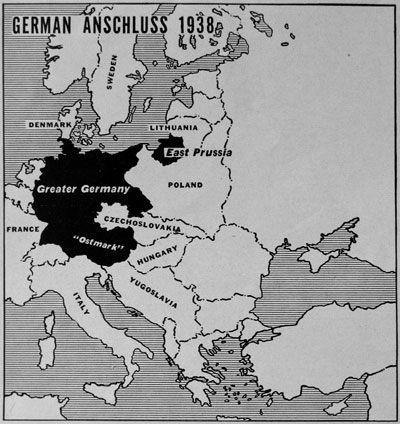
|
The 4th armed SS regiment and the third SS-VT regiment to be formed was a foreshadowing of things to come for Waffen-SS recruits: It was made up primarily of soldiers that were not from Germany. With the annexation of Austria through the Anschluss in 1938 (Which the SS regiments participated in, essentially as training maneuvers), a large pool of sympathetic recruits was opened up. The Austrian 2nd Battalion of SS-VT regiment Deutschland was detached as the 1st battalion core for the SS-VT regiment Der Fuhrer and billeted in Vienna. The regiment title was specifically chosen to denote Austrian acceptance of party leadership loyalty. The other two battalions temporarily drew officers and NCOs from LSSAH and Germania and then the bulk of the units were filled out with Austrian volunteers. This pattern was to be oft repeated later as a way to quickly get a unit up to speed. Leadership cadre were drawn partially from several established units to quickly get a new or rebuilding unit effective. Since the drained source of leadership was spread out from multiple sources, none of them was individually affected harshly.
|
With the formation of a third new SS-VT regiment, the SS-VT had enough regiments of infantry so that the LSSAH could completely detach its parallel role and the SS-VT could form the beginning structure for a division, if necessary, during wartime. A fully functional division needs support to be independent and a variety of separate support battalions had been raised in preparation. Starting back in 1934, the signals battalion was raised from eastern Germany and trained by regular army personnel in communications. The engineer battalion was formed from recruits in central Germany starting in 1935. The Nuremburg battalion was begun in 1936 and later expanded into a motorcycle and anti-tank battalion. Reconnaissance, anti-aircraft and artillery were raised during 1938 through 1939. LSSAH formed its own independent motorised brigade and generally operated separately from the SS-VT. On a separate note: Hitler had thrown the Treaty of Versailles limitations to the side in 1935. The regular armed forces then expanded without treaty limits. The overall German military structure was now referred to as the Wehrmacht and the land forces component (the regular army) was now known as the Heer.
|
The next stage of development for a forming military force involves the most basic situation: Mass coordinated movement. It’s a challenge to coordinate supply of large formations with sub-units having different roles and needs and also to keep the whole mass from becoming confused chaos. Communications and traffic control must be maintained when thousands of troops from multiple formations are moving out and sometimes intermixing with formations from other units. The SS-VT was fortunate to get some real world practice in the early stages before World War II as Nazi Germany was appeased. Due to shifting borders from previous events (most recently World War I) and general ethnic blurring along borders, the western half of Czechoslovakia had a large German population very sympathetic to German rule and this was used as an excuse to take territory, known to Germans as the Sudetenland.
|
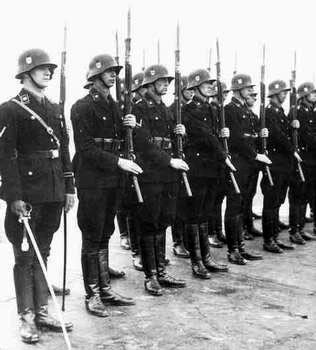 |
Peace for our time was negotiated between England, France, Italy and Adolf Hitler (without Czech participation) for the Sudetenland to be ceded to Germany. The entire SS-VT structure, as well the Heer, gained invaluable experience during the unopposed occupation movement into the Sudetenland in October of 1938. It was an incredible opportunity for a unique training exercise not possible in peacetime. For the SS-VT, it did have a pattern of events soon to come that would temporarily later hamper it, though. As the SS formations were subject to full Heer control, the regiments were not sent in combined as a division, but were sent in split up. It was still crucial experience gained in coordination for all involved, though.
|
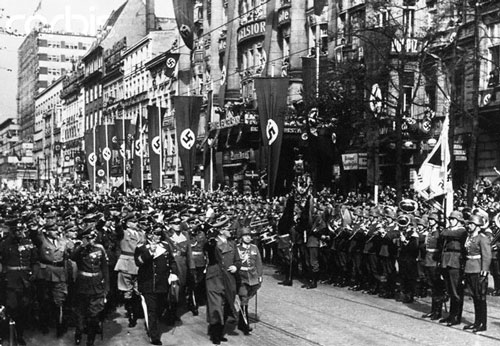 |
With this experience behind them, the SS-VT was to undergo another major development. Despite the structure of a motorised infantry division, they had actually been horse drawn for most assets. This was to change as their now proven military supply capabilities were to finally get full motorised assets. It’s not a simple process for this era when many were still directly unfamiliar with vehicles in Europe. The whole supply/maintenance system often had different needs and personnel needed to be re-trained.
|
| It was not until March 1939 that the SS-VT formations were considered
ready to begin functionality as a truly motorised unit and take to the
field again. Just in time to practice on the rest of Czechoslovakia.
For the majority of the Heer, this was little different than the
maneuvers into the Sudetenland. For the SS-VT, it gave them an
opportunity to completely test their newly trained motorised system.
They were still parceled out as separate regiments, but the Heer was
taking them more seriously this time and the SS-VT was fully integrated
into the plan of operations. |
The German army had a substantial number of World War I veterans in its upper and middle ranks, but the whole Wehrmacht had been suppressed in important ways by its artificially constrained small size mandated by the Treaty of Versailles back when it was the Reichswehr. A rapid expansion after 1935 allowed it to fill its ranks with many partially experienced men in a socially supportive system. Even the fallen SA was a very useful pool of recruits as many ex-members were eager for military service and had previously been participating in what was a paramilitary organisation larger than the armies of many nations.
|
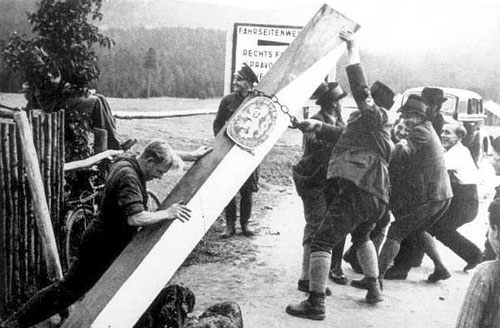
|
|
The large scale troop deployments into Austria,
the Sudetenland and then the remainder of Czechoslovakia gave the
Wehrmacht a chance to bring itself back up to speed on almost a wartime
level of practice for large scale troop maneuvers. The burgeoning SS-VT
that would one day become the Waffen SS was able to graduate to full
capability in this time. Overall, they did very well. Despite several
ordered re-directions and some nasty snow, 4th Regiment (Der Fuhrer) was
the only military formation in its operational sector to reach its
assigned destination on schedule, for instance.
~ Andy.
Read part two, the Combat History here...
Want To Know More About Blitzkrieg?
Over the past few months we have added a massive range of articles
about Blitzkrieg to the website, to make it easier for people to find a
specific article we have put together this handy place.
Find out more about Blitzkrieg and Early-war here...
|
Last Updated On Monday, March 7, 2011 by Blake at Battlefront
|
|
|